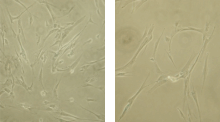
WI-38 is a diploid human cell line composed of fibroblasts derived from lung tissue of a 3-month-gestation female fetus. The fetus came from the elective abortion of a Swedish woman in 1963. The cell line was isolated by Leonard Hayflick the same year, and has been used extensively in scientific research, with applications ranging from developing important theories in molecular biology and aging to the production of most human virus vaccines. The uses of this cell line in human virus vaccine production is estimated to have saved the lives of millions of people.
History
The WI-38 cell line stemmed from earlier work by Hayflick growing human cell cultures.
In the early 1960s, Hayflick and his colleague Paul Moorhead at the Wistar Institute in Philadelphia, Pennsylvania discovered that when normal human cells were stored in a freezer, the cells remembered the doubling level at which they were stored and, when reconstituted, began to divide from that level to roughly 50 total doublings (for cells derived from fetal tissue). Hayflick determined that normal cells gradually experience signs of senescence as they divide, first slowing before stopping division altogether. This finding is the basis for the Hayflick limit, which specifies the number of times a normal human cell population will divide before cell division stops. Hayflick's discovery later contributed to the determination of the biological roles of telomeres. Hayflick claimed that the finite capacity of normal human cells to replicate was an expression of aging or senescence at the cellular level.
During this period of research, Hayflick also discovered that if cells were properly stored in a freezer, cells would remain viable and that an enormous number of cells could be produced from a single starting culture. One of the cell strains that Hayflick isolated, which he named WI-38, was found to be free of contaminating viruses, unlike the primary monkey kidney cells then in use for virus vaccine production. In addition, WI-38 cells could be frozen, then thawed and exhaustively tested. These advantages led to WI-38 quickly replacing primary monkey kidney cells for human virus vaccine production. WI-38 has also been used for research on numerous aspects of normal human cell biology.
Applications
WI-38 was invaluable to early researchers, especially those studying virology and immunology, since it was a readily available cell line of normal human tissue. Unlike the HeLa cell line, which were cancerous cells, WI-38 was a normal human cell population. Researchers in labs across the globe have since used WI-38 in their discoveries, most notably Hayflick in his development of human virus vaccines. Infected WI-38 cells secrete the virus, and can be cultured in large volumes suitable for commercial production.
Virus vaccines produced in WI-38 have prevented disease or saved the lives of billions of people. Vaccines produced in WI-38 include those made against adenoviruses, rubella, measles, mumps, varicella zoster, poliovirus, hepatitis A and rabies.
Genome sequence
The WI-38 cell line was one of the first cell lines whose diploid genome was sequenced. This is critical because most human genome sequences have not been resolved to chromosome level, that is, it remained largely unclear which genetic variant is on which of the two chromatids. Besides being an important cell line for experimental studies (e.g. on aging), the WI-38 line is believed to have remained diploid since it was originally established in 1961. Nearly 60 years later, karyotyping by Soifer et al. (2020) showed that the WI-38 genome has not acquired major rearrangements such as translocations. More importantly, the de novo phased assembly confirms that the genome has in fact remained diploid and retained its heterozygosity throughout. It is therefore a good model for genome sequencing and serves as another reference genome.
See also
References
- "WI-38 (ATCC® CCL-75™)".
- ^ Hayflick L, Moorhead PS (December 1961). "The serial cultivation of human diploid cell strains". Experimental Cell Research. 25 (3): 585–621. doi:10.1016/0014-4827(61)90192-6. PMID 13905658.
- ^ Gorvett Z. "The controversial cells that saved 10 million lives". www.bbc.com. Retrieved 2020-12-09.
- ^ Hayflick L (March 1965). "The Limited in vitro Lifetime of Human Diploid Cell Strains". Experimental Cell Research. 37 (3): 614–36. doi:10.1016/0014-4827(65)90211-9. PMID 14315085.
- ^ Fletcher MA, Hessel L, Plotkin SA (1998). "Human diploid cell strains (HDCS) viral vaccines". Developments in Biological Standardization. 93: 97–107. PMID 9737384.
- ^ Olshansky SJ, Hayflick L (2 March 2017). "The Role of the WI-38 Cell Strain in Saving Lives and Reducing Morbidity". AIMS Public Health. 4 (2): 127–138. doi:10.3934/publichealth.2017.2.127. PMC 5689800. PMID 29546209.
- ^ Wadman M (June 2013). "Medical research: cell division". Nature. 498 (7455): 422–6. Bibcode:2013Natur.498..422W. doi:10.1038/498422a. PMID 23803825.
- ^ Shay JW, Wright WE (October 2000). "Hayflick, his limit, and cellular ageing" (PDF). Nature Reviews. Molecular Cell Biology. 1 (1): 72–6. doi:10.1038/35036093. PMID 11413492. S2CID 6821048. Archived from the original on 2010-07-13.
{{cite journal}}: CS1 maint: bot: original URL status unknown (link) - Holliday R (2012). "Telomeres and telomerase: the commitment theory of cellular ageing revisited". Science Progress. 95 (Pt 2): 199–205. doi:10.3184/003685012X13361526995348. PMC 10365536. PMID 22893980. S2CID 20557366.
- ^ Hayflick L. "Errors in the "Vaccine Race" Book" (PDF). Archived from the original (PDF) on 2019-01-22. Retrieved 2018-04-24.
- ^ Soifer L, Fong NL, Yi N, Ireland AT, Lam I, Sooknah M, et al. (September 2020). "Fully Phased Sequence of a Diploid Human Genome Determined de Novo from the DNA of a Single Individual". G3. 10 (9): 2911–2925. doi:10.1534/g3.119.400995. PMC 7466960. PMID 32631951.
External links
- Cellosaurus entry for WI-38
- Medical research: Cell division, by Meredith Wadman, 26. Jun 2013, Nature